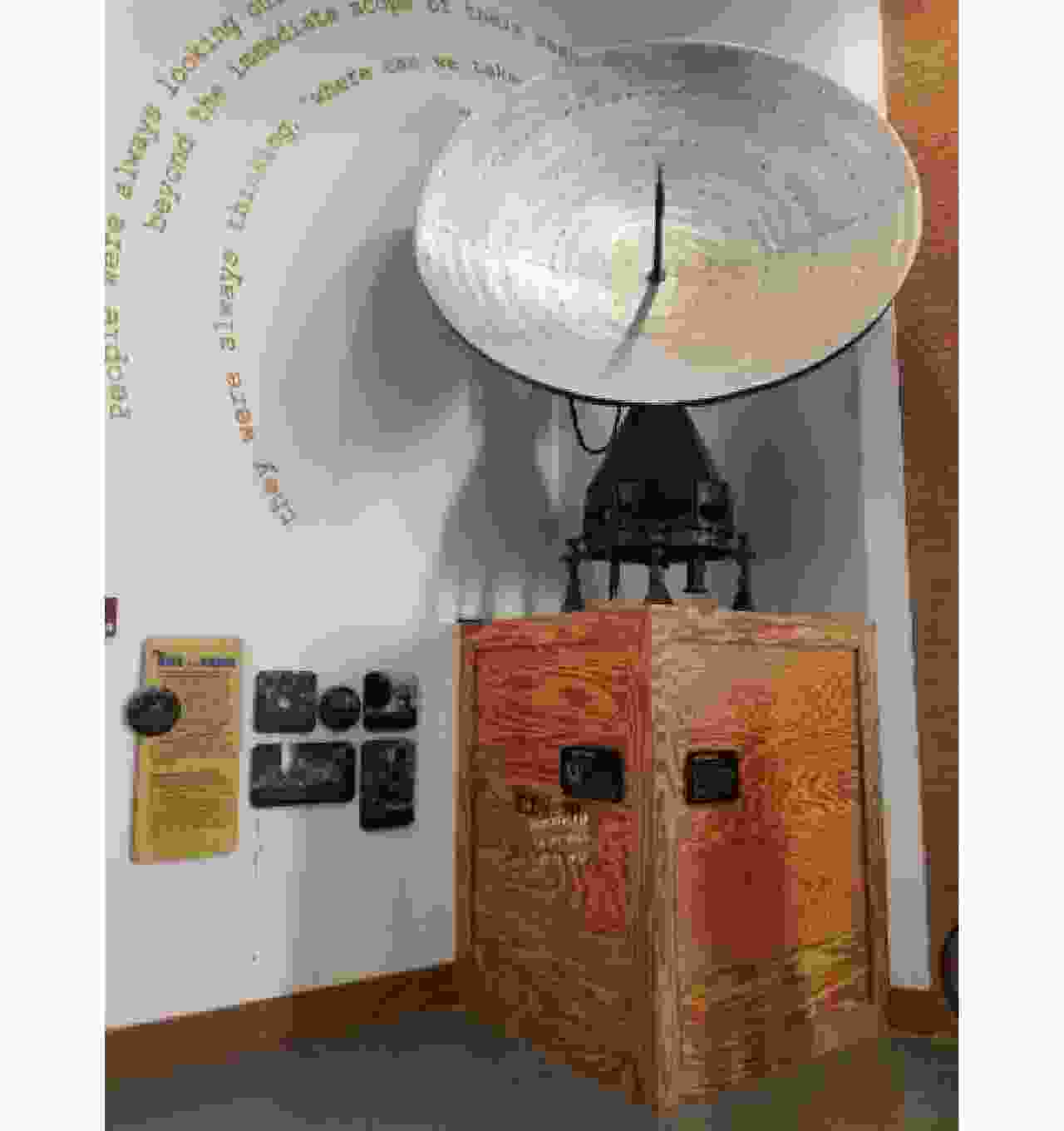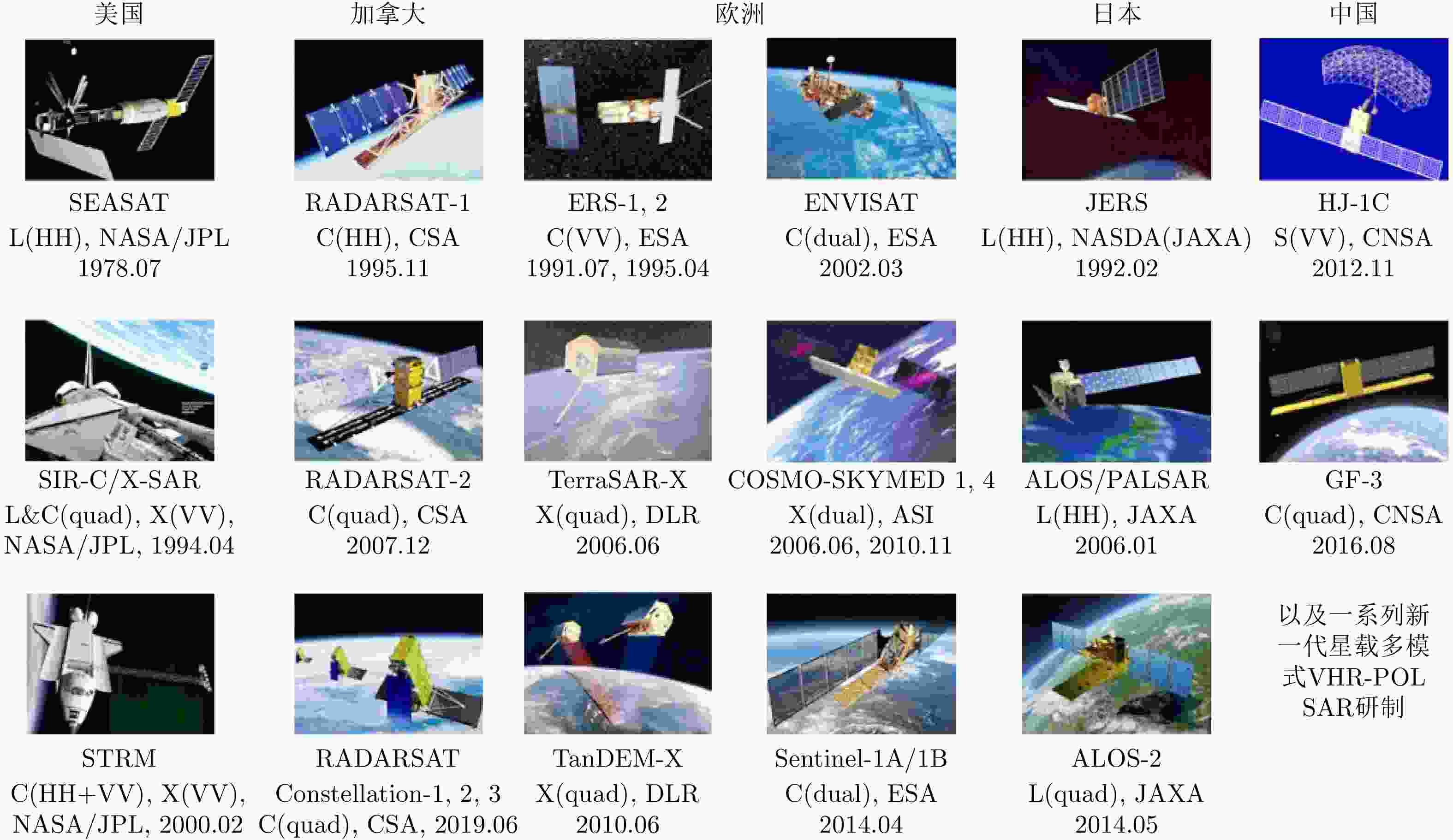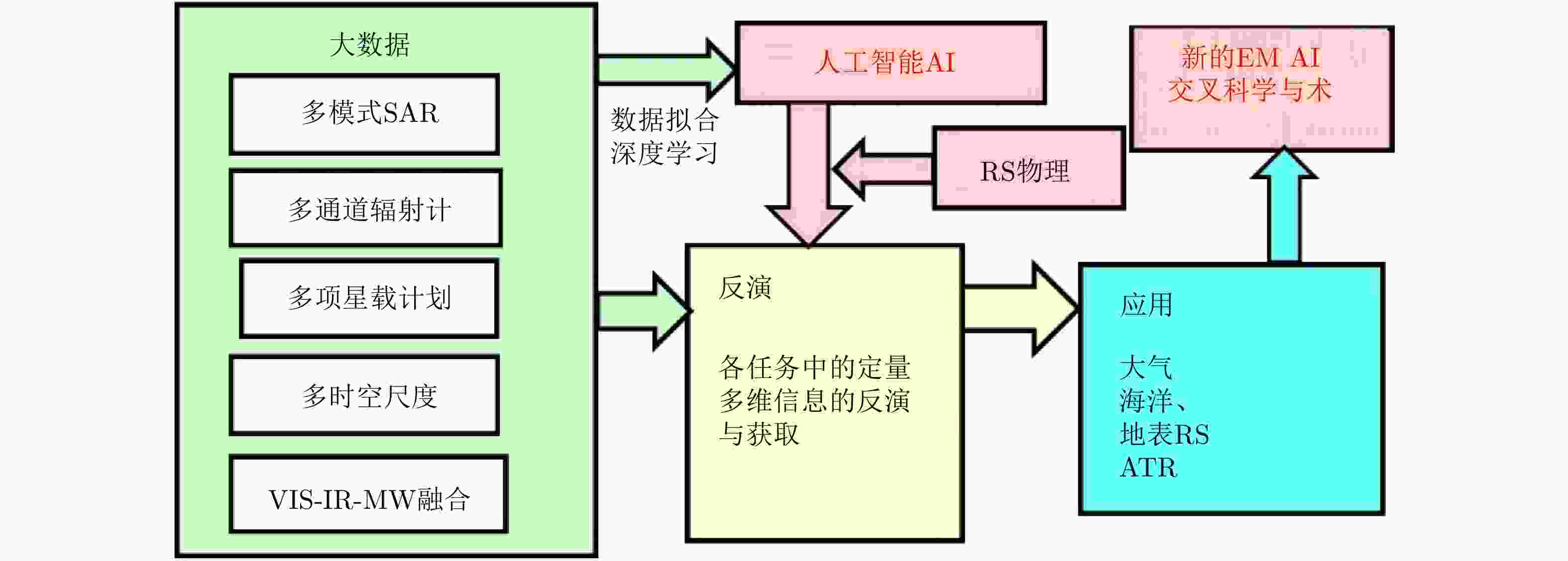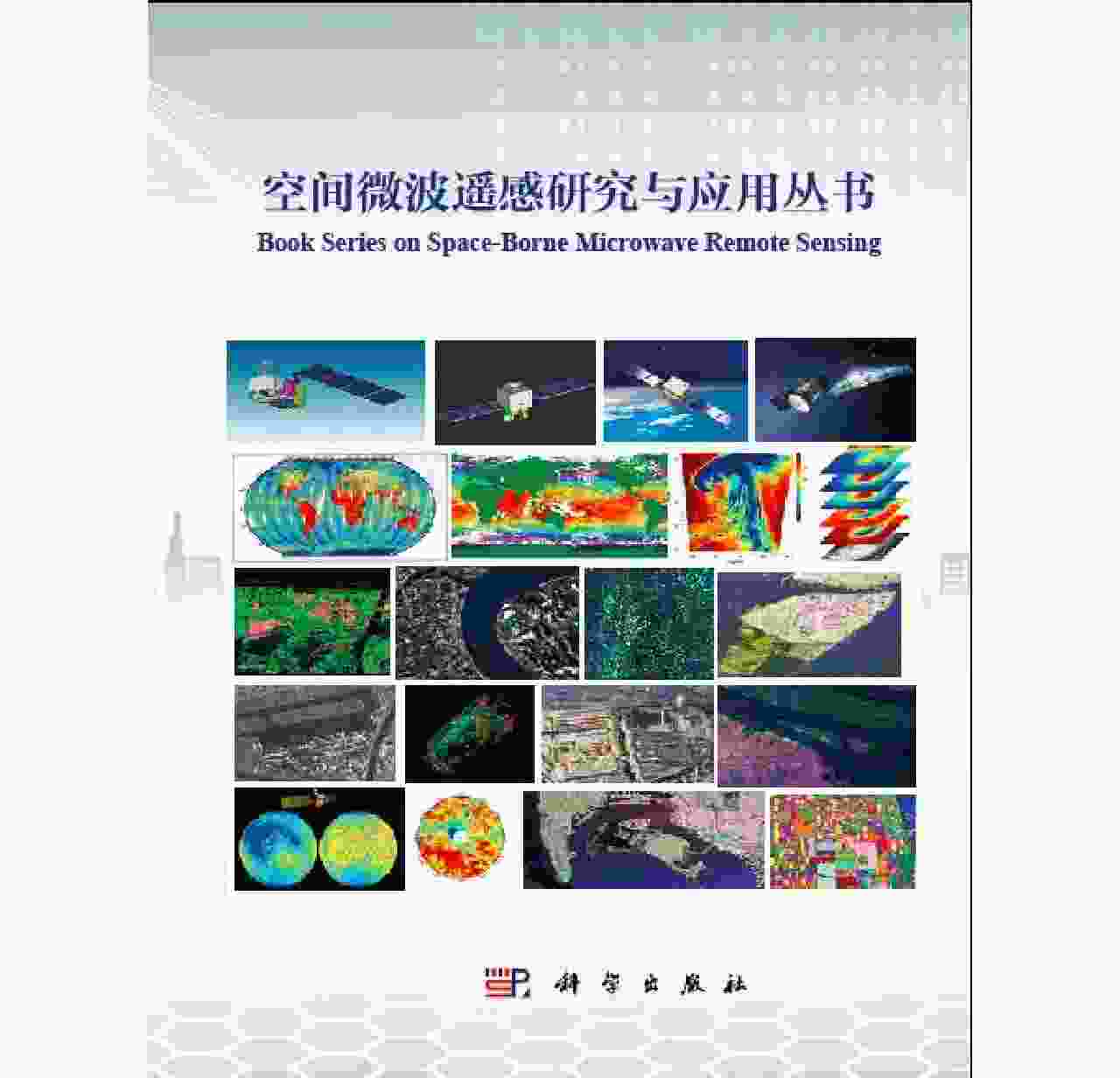Multimode Remote Sensing Intelligent Information and Target Recognition: Physical Intelligence of Microwave Vision (in English)
-
摘要:
多模式高分辨率合成孔径雷达(SAR)的发展,对天空地海环境目标信息感知与特征获取提出了新的挑战,空间遥感大数据与人工智能信息技术的交叉是自动目标识别(ATR)一个新的研究方向与重大应用领域。该文提出,在电磁波与目标相互作用的物理背景下进行人工智能信息技术的研究,即“物理智能”,以发展在人眼不能识别的电磁频谱上形成信息感知的“微波视觉”,实现多模式遥感智能信息与目标识别。该文主要内容基于作者2019年8月15日在“雷达学报第五届青年科学家论坛”上的学术报告。
Abstract:The development of multimode high-resolution Synthetic Aperture Radar (SAR) poses new challenges to information perception and feature abstraction of the space, ground, sea, and environment targets. The intersection of spatial remote sensing big data and artificial intelligence information technology is a new scientific research domain and major application area in Automatic Target Recognition (ATR). We emphasize that research on artificial intelligence information technology needs to be conducted under the physical background of the interaction between electromagnetic waves and targets, i.e., physical intelligence, to develop microwave vision of information perception on the electromagnetic spectrum that cannot be recognized by human eyes. This study is based on a keynote speech presented by author at the Fifth Young Scientists Forum of Journal of Radars on August 15, 2019.
-
-
[1] MIT Schwarzman College of Computing. The MIT Stephen A. Schwarzman College of Computing aims to address the global opportunities and challenges presented by the ubiquity of computing — across industries and academic disciplines — perhaps most notably illustrated by the rise of artificial intelligence[EB/OL]. http://computing.mit.edu/about/, 2018. [2] L Rafael Reif. Prepare students for a future of artificial intelligence[EB/OL]. https://president.mit.edu/speeches-writing/prepare-students-future-artificial-intelligence/2019-02-10. [3] 李婕敏. 美国白宫积极布局人工智能未来发展[J]. 现代军事, 2017(S1): 20–21.LI Jiemin. The White House is actively planning the future development of artificial intelligence[J]. conmilit, 2017(S1): 20–21. [4] DARPA announces $2 billion campaign to develop next wave of AI technologies[EB/OL]. https://www.darpa.mil/news-events/2018-09-07. [5] 2018年国防部人工智能战略概要——利用人工智能促进安全与繁荣[EB/OL]. http://www.defense-aerospace.com/articles-view/reports/2/199929/pentagon-releases-artificial-intelligence-strategy.html, 2019.Summary of the 2018 Department of Defense Artificial Intelligence Strategy——Harnessing AI to Advance Our Security and Prosperity[EB/OL]. http://www.defense-aerospace.com/articles-view/reports/2/199929/pentagon-releases-artificial-intelligence-strategy.html, 2019. [6] AI next campaign[EB/OL]. https://www.darpa.mil/work-with-us/ai-next-campaign. [7] Gouvernement. fr. FranceIA: The national artificial intelligence strategy is underway[EB/OL]. https://www.gouvernement.fr/en/franceia-the-national-artificial-intelligence-strategy-is-underway, 2017. [8] 详解世界各国的人工智能布局[EB/OL]. https://blog.csdn.net/R1uNW1W/article/details/78399834, 2017.Detailed understanding of the world's AI layout[EB/OL]. https://blog.csdn. net/R1uNW1W/article/details/78399834, 2017. [9] JapanGov. Artificial intelligence: a rival for humans, or A Partner?[EB/OL]. https://www.japan.go.jp/tomodachi/2018/spring2018/artificial_intelligence.html, 2018. [10] 新一代人工智能发展规划[EB/OL]. http://www.gov.cn/xinwen/2017-07/20/content_5212064.htm, 2017.A new generation of the AI development plan[EB/OL]. http://www.gov.cn/xinwen/2017-07/20/content_5212064.htm, 2017. [11] 国家自然科学基金人工智能基础研究应急项目指南[EB/OL]. http://www.nsfc.gov.cn/publish/portal0/tab452/info69927.htm.National natural science foundation’s AI-based basic research emergency project guide[EB/OL]. http://www.nsfc.gov.cn/publish/portal0/tab452/info69927.htm. [12] XU Feng and JIN Y. Remote sensing with intelligent processing 2017 in Shanghai, China[J]. IEEE Geoscience and Remote Sensing Magazine, 2017, 5(4): 108–123. doi: 10.1109/MGRS.2017.2760619 [13] ZHOU Yu, WANG Haipeng, XU Feng, et al. Polarimetric SAR image classification using deep convolutional neural networks[J]. IEEE Geoscience and Remote Sensing Letters, 2016, 13(12): 1935–1939. doi: 10.1109/LGRS.2016.2618840 [14] SONG Qian and XU Feng. Zero-shot learning of SAR target feature space with deep generative neural networks[J]. IEEE Geoscience and Remote Sensing Letters, 2017, 14(12): 2245–2249. doi: 10.1109/LGRS.2017.2758900 [15] CHEN Sizhe, WANG Haipeng, XU Feng, et al. Target classification using the deep convolutional networks for SAR images[J]. IEEE Transactions on Geoscience and Remote Sensing, 2016, 54(8): 4806–4817. doi: 10.1109/TGRS.2016.2551720 [16] ZHANG Zhimian, WANG Haipeng, XU Feng, et al. Complex-valued convolutional neural network and its application in Polarimetric SAR image classification[J]. IEEE Transactions on Geoscience and Remote Sensing, 2017, 55(12): 7177–7188. doi: 10.1109/TGRS.2017.2743222 [17] 徐丰, 金亚秋. 从物理智能到微波视觉[J]. 科技导报, 2018, 36(10): 30–44. doi: 10.3981/j.issn.1000-7857.2018.10.004XU Feng and JIN Yaqiu. From the emergence of intelligent science to the research of microwave vision[J]. Science&Technology Review, 2018, 36(10): 30–44. doi: 10.3981/j.issn.1000-7857.2018.10.004 [18] 金亚秋, 徐丰. 加强智能科学交叉领域研究[J]. 科技导报, 2018, 36(17): 1.JIN Yaqiu and XU Feng. To strengthen the research on the intersection of intelligence science[J]. Science&Technology Review, 2018, 36(17): 1. [19] 金亚秋, 徐丰. 极化散射与SAR遥感信息理论与方法[M]. 北京: 科学出版社, 2008.JIN Yaqiu and XU Feng. Theory and Approach for Polarimetric Scattering and Information Retrieval of SAR Remote Sensing[M]. Beijing: Science Press, 2008. [20] 姜景山, 吴一戎, 金亚秋. 空间微波遥感研究与应用丛书[M]. 北京: 科学出版社, 2019–2020.JIANG Jingshan, WU Yirong, and JIN Yaqiu. Book Series on Space-Borne Microwave Remote Sensing[M]. Beijing: Science Press, 2019–2020. [21] 徐丰, 王海鹏, 金亚秋. 雷达图像智能信息解译与应用[M]. 北京: 科学出版社, 2020.XU Feng, WANG Haipeng, and JIN Yaqiu. Intelligent Interpretation of Radar Image Information[M]. Beijing: Science Press, 2020. [22] 徐丰, 王海鹏, 金亚秋. 深度学习在SAR目标识别与地物分类中的应用[J]. 雷达学报, 2017, 6(2): 136–148. doi: 10.12000/JR16130XU Feng, WANG Haipeng, and JIN Yaqiu. Deep learning as applied in SAR Target recognition and terrain classification[J]. Journal of Radars, 2017, 6(2): 136–148. doi: 10.12000/JR16130 [23] YUE Dongxiao, XU Feng, and JIN Yaqiu. SAR despeckling neural network with logarithmic convolutional product model[J]. International Journal of Remote Sensing, 2018, 39(21): 7483–7505. doi: 10.1080/01431161.2018.1471539 [24] SONG Qian, XU Feng, and JIN Yaqiu. Radar image colorization: Converting single-polarization to fully polarimetric using deep neural networks[J]. IEEE Access, 2017, 6: 1647–1661. -



 作者中心
作者中心 专家审稿
专家审稿 责编办公
责编办公 编辑办公
编辑办公

 下载:
下载:















